Olympic Park in Summer Overview
Learn About Visiting Olympic National Park in the Summer
Summer is one of the best times of year to visit Olympic National Park because the weather is most amicable and the park is beautiful. The landscape is lush after a wet spring, and with over 140 inches of annual rainfall, the year-round moisture creates incredible waterfalls and wildflowers. Since Olympic National Park contains over 600 miles of hiking trails, and 95% of the park is Congressionally-designated wilderness, there are plenty of ways to escape the crowds. Visiting in the summer has many benefits, as well as some drawbacks. In this guide, we will go into detail about what to expect when visiting in June, July, and August.
BENEFITS OF VISITING IN SUMMER
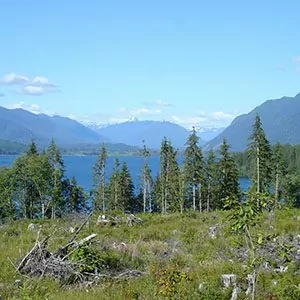
There are many benefits of visiting the Olympic National Park in the summer. First, the weather is most pleasant in the summer, with temperatures that are mild to warm, and a “dry” climate—although rain is always a possibility, so it is important to carry rain gear. Second, all roads in the park are open and accessible, after Hurricane Ridge Road opens in April. You can check the road conditions for the most up-to-date information. Last but not least, there are great chances to encounter wildlife in the summer, as they are soaking up the vitamin D as much as we are! Blacktail deer and Roosevelt elk are commonly seen in the river valleys and rainforests. Olympic marmots, a species endemic to Washington, are often found sunbathing on warm rocks at Hurricane Ridge. And marine mammals, such as sea otters, seals, and sea lions are often seen along the coast, at Kalaloch, Ruby, and Rialto Beaches. Humpback whales are also likely to be seen along the Olympic Coast during the summer months, you can check out the Whale Trail’s viewing guide and interactive map to find the best viewing locations.
DRAWBACKS OF VISITING IN SUMMER
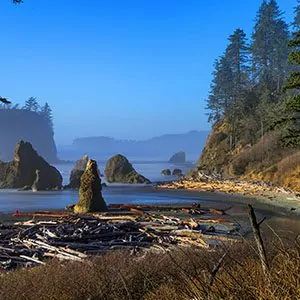
The biggest drawback to visiting Olympic National Park in the summer is the crowds. Summer is the busiest time of year, helping make Olympic NP the 7th most visited National Park in the United States, with three-quarters of its yearly visitation in June, July, and August. Although the park is definitely more crowded in the summer, don’t let that deter you from visiting, there are many ways that you can be prepared and avoid the congestion:
Do your research: knowing where you want to go and what you want to see before you get to the park is crucial. Olympic is a big park, with many different and distinct areas; if you have done your research beforehand, you won’t have to crisscross all over the park to see what you want to see. Check out the park’s mileage chart to help you plan your driving.
Get an early start: many areas fill up as the day progresses, so getting your day started early is essential. Many areas of the park have their own entrance station, and when the parking lots fill, a queue line is started at the entrance station, one car entering at a time as another car leaves. On busy summer afternoons, the wait time can be up to three hours! Avoid wasted time in your car, as well as stress, by getting to popular parking areas before 10 o’clock.
Go backpacking: 95% of Olympic National Park is designated wilderness. The best way to avoid the crowds is to go deep in the wilderness that you can only get to on foot.
Make reservations in advance: it is important to plan ahead and get reservations/ permits before entering the park. Backpacking permits are required for all overnight wilderness camping, and popular backcountry destinations may fill well in advance. The same is true for tours, boating, and other activities.
Book a guided trip: take the stress out of planning a hiking trip by going with a guiding company that takes care of all the logistics and provides exceptional gear, knowledgeable guides, and delicious backcountry meals.

CLIMATE AND TEMPERATURE IN SUMMER
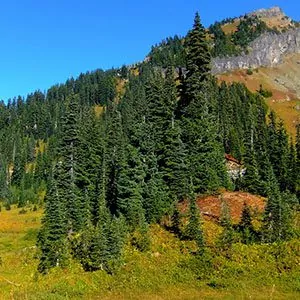
Depending on your location within the park, summer can have very mild to warm temperatures; although rain is always possible, thunderstorms are most likely to occur at higher elevations. On any given day, the temperature can range up to ten degrees from the mountains to the coast, so it is always important to bring layers. Check the current forecast for Hurricane Ridge, Quinault Rainforest, and Rialto Beach. Below are the average temperatures and days of precipitation for the three locations:
| Month | Hurricane Ridge | Quinault Rainforest | Rialto Beach | Days of Precip | |||
| Avg Hi | Avg Lo | Avg Hi | Avg Lo | Avg Hi | Avg Lo | ||
| June | 49°F (9°C) | 32°F (0°C) | 67°F (19°C) | 48°F (8°C) | 65°F (18°C) | 49°F (9°C) | 10 Days |
| July | 57°F (13°C) | 39°F (3°C) | 74°F (23°C) | 51°F (10°C) | 68°F (20°C) | 52°F (11°C) | 6 Days |
| August | 57°F (13°C) | 39°F (3°C) | 75°F (23°C) | 52°F (11°C) | 69°F (20°C) | 52°F (11°C) | 5 Days |
THINGS TO DO IN SUMMER
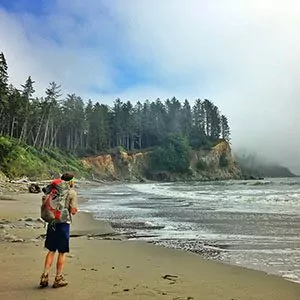
Summer is the best time for activities in Olympic National Park. The weather is near-perfect and provides many opportunities to try new things or to continue doing the things you have always loved. Below are the most popular things to do in Olympic National Park in the summer:
Hiking: Summer is the best time of the year for hiking in the park. With 611 miles of trails, ranging from easy to strenuous, you are bound to find a trail that sparks your interest. Olympic National Park is home to beautiful and diverse landscapes, including rugged and dramatic coastlines, sandy beaches, dense rainforests, colorful wildflowers, alpine lakes and glaciers, and cascading waterfalls. There is truly something for everyone in Olympic National Park. Since 95% of the park is considered wilderness, it is easy to escape the hustle and bustle of everyday life on one of these majestic trails. Below we have details about our favorite hikes to do in the summer.
Backpacking: There is no better way to experience Olympic’s wild side than on a multi-day backpacking trip. You can maximize your time in the park and escape the crowds, by spending a couple of nights under the stars in the backcountry. Summer is one of the best times for backpacking because the weather is so nice during the day and the trails to alpine lakes and glaciers are accessible. Best of all, there is something for everyone in Olympic National Park. If you are with your family, there are beginner trails that are flat and easy. If you are a seasoned backpacker, there are challenging, long-distance trails into remote areas of the park. Below we have listed our favorite backpacking trips in the park, so you can be an expert by the time you get to the trailhead.
Fishing: As the weather warms, fish become more aggressive and more likely to bite, making the summer a fantastic time for fishing in Olympic National Park. The best spots in the summer are in the Elwha River Valley and along the coast. Steelhead and trout are most common in the Elwha River, and Cutthroat trout, Redtail surfperch, and rockfish are most common along the coast in the summer. A Washington State Recreational Fishing License is required for fishing along the coast into the Pacific Ocean. And, a Washington State Catch Record Card is required when you catch salmon or steelhead.
Boating: One of the best ways to explore Olympic National Park is on the water; with rivers, lakes, and oceans, there are many water activities you can enjoy, from whitewater kayaking to paddleboarding. Boat and paddleboard rentals are available on Lake Crescent and Lake Quinault, and Lake Ozette hosts many backcountry campsites for those who are wanting to spend the night along the lakeshore.
Wildlife Viewing: Summer is the best time to watch the park’s wildlife in their natural habitat. To be successful in your viewing, you will want to watch at dusk and dawn when animals are most active, and you will want to know each animal’s habits and habitats. Black-tail deer are commonly seen in forested and mountainous environments—best viewed near Hurricane Ridge, or the Hoh, Quinault, or Queets Rainforests. Roosevelt elk are best viewed in the lush landscape of the Hoh, Quinault, and Queets Rainforests, as well. And Olympic marmots, found nowhere else in the world, are seen at Hurricane Ridge, often sunbathing on rocks before hibernating for the entire winter. In addition, birdwatching is spectacular near Lake Quinault. Check out the Audubon Society for a full list of birds in Olympic National Park.
Night Sky Viewing: In the summer, the National Park Service partners with Olympic Telescope to provide free nighttime telescope programs. The programs are offered each night and meet at the Hurricane Ridge Visitor Center. Check with a park ranger for details about what time the viewing starts.
HIKING IN OLYMPIC IN SUMMER
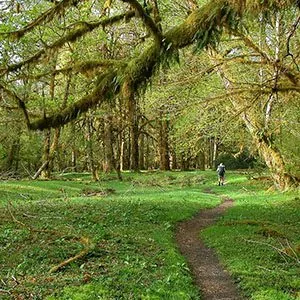
Summer is the best time of year for hiking in Olympic National Park. The park is vibrant with colors and life, and the weather is usually clear, letting you see for miles when you are up high. Below we have described our favorite hikes in the park; with so many different trails, you are bound to find your own favorite!
1. PONY BRIDGE
- Trailhead: East Fork of Quinault River
- Distance: 4.8 miles roundtrip
- Elevation Gain: 600 feet
This 5-mile hike through the Quinault Rainforest is called “Enchanted Valley” for a reason. The lush, fern-covered rainforest is green with life and wisdom, enchanting all who walk through. Hiking along the North Fork of the Quinault River, this trail to Pony Bridge will take you deep into the rainforest without much effort or elevation gain. Sitka spruce, mosses, ferns, and berries grow abundantly along the path, which leads you up a ridge, and down the other side. A short spur trail leads you to an incredible overlook of the vibrant river flowing through a narrow gorge. Once back on the main trail, you will continue down to the bridge, giving you an up-close and personal experience with the brilliant blue-green river. Take a break here; enjoy the beautiful scenery and eat a snack, then simply turn around and head to the trailhead the same way you came.
2. MAIDEN PEAK
- Trailhead: Obstruction Point Trailhead
- Distance: 9 miles roundtrip
- Elevation Gain: 2100 feet
Start your hike at the Obstruction Point Trailhead, just before the Deer Park Ranger Station. This is a moderately-strenuous, 9-mile roundtrip hike, taking you on one of the highest trails in Olympic National Park. Obstruction Point trail descends 400 feet in the first mile, and then gains it back, climbing 700 feet in the second mile. As you reach the base of Green Mountain, you are treated to remarkable vistas, but this is just a small glimpse of what is yet to come. Traversing Green Mountain, the meadow starts to open up, and you get broad and expansive views on all sides. To get to the summit of Maiden Peak, you will have to scramble up a boulder field with no trail, but once you get to the top, the views are incredible. You can look down on the Grand Ridge trail winding up the side of Elk Mountain, as well as Mount Angeles, Klahhane Ridge, Hurricane Ridge, and the Strait of Juan de Fuca.
3. HOLE-IN-THE-WALL
- Trailhead: Rialto Beach parking area
- Distance: 4 miles roundtrip
- Elevation Gain: 0 feet
Hole-in-the-Wall is a Swiss-cheese-looking rock face, created by waves that carve away softer rock, leaving a hole in the harder rock. The opening is large enough for a person to stand beneath and offers spectacular photographic opportunities to capture the sea stacks framed in the opening. This easy stroll along the coast is just 3 miles roundtrip and takes you past some of the most phenomenal features that the Olympic Coast has to offer. Ancient, fern and moss-covered sea stacks are scattered throughout the water, birds are soaring in the air and scavenging on the beach, and a lush old-growth forest is alive with wisdom and mystery. If you arrive at Hole-in-the-Wall at low tide, you can walk through the rocky opening, and gaze into the tidepools, vibrant with colorful sea urchins and sea cucumbers. However, if you arrive at high tide, you can take the overland route above the rock to get a panoramic view. Make sure you know the times of high and low tide, and take a look at tide predictions before you get started!
4. MOUNT STORM KING
- Trailhead: Storm King Ranger Station
- Distance: 4 miles roundtrip
- Elevation Gain: 535 feet
Start at the Storm King Ranger Station, on the southeastern shore of Lake Crescent. The trail will start out taking you to Marymere Falls, but don’t be fooled by how flat the trail is, it’s not going to stay this way. At a ½ mile, you will reach a giant boulder that doubles as a trail marker, taking you uphill. On a series of switchbacks, you will pass through a dense forest, covered in ferns and mosses, until the forest opens and the trail flattens. Views start to appear when the pines fade away and are replaced by madrones and manzanitas. There are several viewpoints that give you that famous shot of an outcropping over Lake Crescent. The maintained trail, however, ends at 1.3 miles. Hikers should be advised that although you can continue, the trail is rocky and exposed, and there is a section where you will need to hold on to a rope. Be careful, enjoy the view, and return to the trailhead the same way you came.
BACKPACKING IN OLYMPIC IN SUMMER
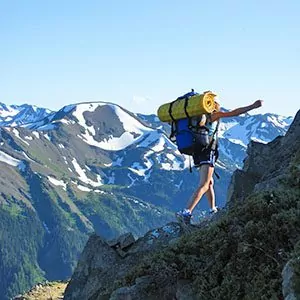
Backpacking in Olympic National Park is near-perfect in the summer—the weather is wonderful, the scenery is spectacular, and there are so many great options to choose from. There are countless trails that will take you past waterfalls and rushing rivers, through fields of wildflowers, and allow you to view wildlife. Check out the park’s backcountry trail map to see which campsite will be best strung together for your next adventure!
- Trailhead: Shi Shi Beach
- Distance: 19.4 miles
- Days to complete: 3-4
Begin your journey at Shi Shi Beach, on the Makah reservation, and hike 19 miles to Ozette Lake. Although the mileage is relatively low on this trip, the terrain is dramatic, with bowling ball-sized boulders that are slick with wet moss and algae, steep overland routes, and the pressure to make a crossing before the tide rolls in. But, this dramatic terrain is what makes the landscape so beautiful, and high risk means high rewards along the North Coast. You can expect stunning sunsets, endless stretches of pristine and uninhabited beaches, ancient rock spires, and tiny sea creatures in tidepools. It is best to do this over the course of 3-4 days; from Shi Shi Beach, you will head south along the coast, then turn inland on the boardwalks to Lake Ozette. Arrange a shuttle beforehand, or do the return hike back to your car.
Let an experienced guide lead you along the North Coast Route on a guided backpacking trip. The guiding company will take care of all the logistics and planning, so you don’t have to stress about anything. All appropriate gear, gourmet backcountry meals, and transportation is included, letting you fully enjoy your Olympic National Park vacation.
2. HOH RIVER TRAIL
- Trailhead: Hoh River Trail
- Distance: 37 miles
- Days to complete: 5
Backpacking through the Hoh Rainforest is absolutely perfect in the summer. The rainforest can experience up to 140 inches of rain throughout the year—most of that rain occurring from November through April. With so much rain over the winter and spring, backpacking through this area of the park is extraordinary in the summer. Along the route, you can expect to see a dense old-growth forest, with mosses and ferns covering every inch, colorful wildflower-speckled meadows, and the raging Hoh River. Because of the shelter that the old-growth trees provide, the Hoh Rainforest is a great habitat for many of the park’s wildlife. Keep your eye out for deer, elk, beavers, and owls. There are many wilderness campsites along the Hoh River, ranging in distance from 3 miles (Mt. Tom Creek) to 17.4 miles (Blue Glacier at Mount Olympus), so you can choose how long you want the trip to be. The first half of the trail is relatively flat, gaining only 350 feet over 10 miles, once you reach the Olympus Ranger Station, however, the trail starts to gain serious elevation as it traverses the side of Mount Olympus. Hiking the Hoh River Trail all the way to the end is a great way to experience the diversity of Olympic National Park.
Choose to go on a guided backpacking trip, where an experienced guide will lead you up to Blue Glacier on a 5-day, Hoh River Traverse. With all the appropriate gear and delicious backcountry meals provided, you can rest easy knowing that you are in good hands, as your safety is the company’s main priority.
3. ELWHA VALLEY TO QUINAULT RIVER
- Trailhead: Whiskey Bend Trailhead (going north to south) or North Fork Trailhead (going south to north)
- Distance: 44 miles
- Days to complete: 4-5
Backpacking from Elwha Valley (just south of Port Angeles) to the North Fork of the Quinault River (just north of Lake Quinault) is quite an epic journey. The trail takes you into wilderness that you can only get to on foot, and provides you with untouched old-growth rainforests, deep river valleys, and alpine meadows with expansive views. Going north to south, you will retrace the footsteps of the historic “Press Expedition”, which, in 1889, sponsored by the Seattle Press, left Port Angeles in hopes of exploring the wilderness of the Olympic Wilderness. Six months later they arrived at Quinault Lake. Nowadays, it takes backpackers only four to five days to complete the same journey. By traveling into the most remote areas of the park, you will be able to say that you traversed the entire length of Olympic National Park.
Let Wildland Trekking take you on a Historic Press Traverse guided backpacking trip, where your local guide will share their knowledge about the historic expedition, in addition to the ecology and history of this diverse landscape.
Join a Guided Hiking Adventure
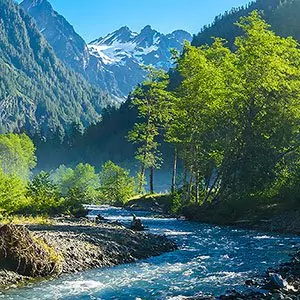
Olympic National Park is home to some of the most epic and amazing hiking vacations in the world. Wildland Trekking offers trips with the best of Olympic NP: the coast, the mountains, wildlife, solitude, adventure, and fascinating natural and cultural interpretation. Guided Olympic National Park treks are all-inclusive which covers permits, local transportation (excluded on certain tours), meals, equipment, safety systems, and professional hiking/wilderness guides; all of which allow visitors to maximize their time in Olympic and focus entirely on enjoying the Park.
OLYMPIC ADVENTURE TOURS
- GUIDED BACKPACKING ADVENTURES: these are for people interested in an authentic Olympic National Park adventure away from the roads and crowds.
- INN-BASED PACKAGES: these tours are all-inclusive packages with lodging, amazing daily hikes, expert guides, meals, transportation, and more!
- CAMPING-BASED HIKING PACKAGES: camping-based hiking packages provide all-around hiking experiences of the Olympic Coast on wonderful outdoor vacations.
- DAY HIKE TOURS: maximize your day in Olympic National Park on a fully guided, award-winning hiking tour on one of the Park’s best trails.





